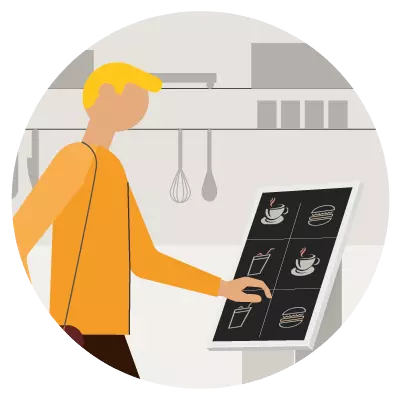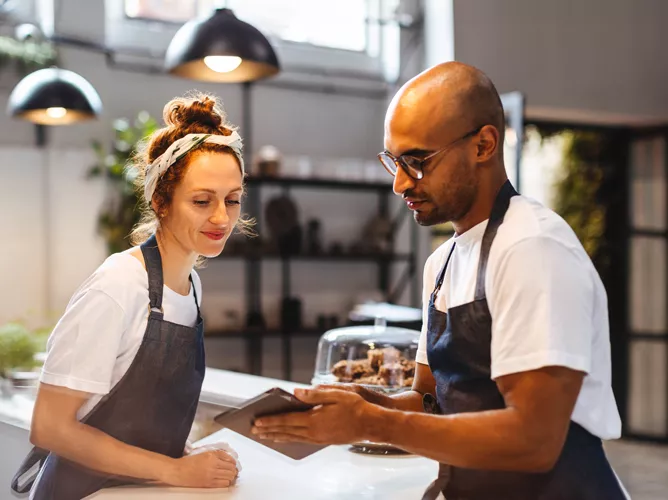By: Marissa Nolan and Guillermo Alvarez
Published: May 13, 2024 | Updated: May 28, 2024
Read time: 7 minutes
- Table of Contents
Introduction
Starting as early as the 1900s, people made predictions about what the restaurant industry would look like hundreds of years later. Some expected serving astronomically large vegetables and fruits. Others predicted full meals condensed down into the form of pure liquid or pills. Some even envisioned meals being delivered by rocket ships around the globe.
Although some predictions have missed the mark, one prediction they got right was the prevalent use of technology in restaurants. While obvious now, the idea of using electricity to power the tools in the kitchen was novel then. Today, as technology continues to accelerate, other visions like robotic hosts that greet and seat consumers are starting to come to pass. Restaurant tech is here to stay with its many uses gaining footholds in the industry.
As the industry moves forward through the 21st century, technology that once sounded outlandish in a restaurant setting, from artificial intelligence (AI) to augmented reality, is a reality. Below are trending technologies that help brands in all touchpoints of restaurant operations and the customer experience
Industry environment
Consumers may prioritize their spending, but there remains an appetite for dining out, so brands are adjusting their strategies to win consumer wallet share and loyalty. Value is increasingly important, meaning that restaurants are providing offers, bundles and deals that may yield smaller profit, but ultimately bring in increased traffic and sales.
But cheaper options aren’t enough. Those who return to a business are the consumers who had good experiences throughout the entire consumer journey. Staff play a key role in that journey and one of the biggest challenges facing restaurants is adjusting to increased cost of labor. With minimum wage increases, some restaurants are looking to technology to sustain sales and offset those rising costs.
Customer experience
Customer experience means more than human interaction inside a store. It now refers to the holistic journey a consumer takes throughout their ordering and fulfillment process. Ease, accuracy, consistency and customer service all play into their overall satisfaction. Technology that improves this customer experience reduces friction for consumers, and those seamless experiences drive return.
Automated customer service and AI chatbots
Front-facing services like customer service phone lines can be unpredictable depending on human experience. Automation helps minimize the amount of negative interactions, which keeps the consumer happy and frees up restaurant staff to provide a strong customer experience. For these reasons and more, many major brands are looking to automation as a solution.
One trending tool is chatbots. These chatbots can guide digital consumers through websites, offer promotions, answer basic questions and take orders — even in multiple languages. According to CloudKitchens, up to 46% of restaurant owners are already automating their customer communications to streamline their business.

Chipotle has “Pepper,” the AI-powered concierge chatbot that quickly addresses customer questions and complaints through their Facebook page, while Domino’s has “Dom the Pizza Bot,” the messenger bot that takes orders through their main site or their social media channels with a single word or emoji. As the ease of online ordering increases, the barriers for consumers to use this more convenient mode decreases. Plus, without workers spending time taking orders and answering phones, that labor can be reallocated or reduced, saving the restaurant time and money.
Hyper-personalization
In the above, there is no doubt that the chatbots increase restaurant efficiency, but that’s not their only benefit. Robot intermediaries can also increase consumer connection to the brand thanks to their ability to hyper-personalize interactions, i.e., providing an experience that is highly targeted and allows the customer to feel personally catered to on a 1:1 level.
The most seamless experience is when a consumer’s needs are anticipated for them with relevant and wanted options. It’s through hyper-personalization that this can be a reality for each individual consumer.
With consumer-permissioned data, loyalty programs can be personalized to serve messages based on past customer behavior and forecasted future behavior. Brands like Panera have one-swipe ordering, Starbucks’ Deep Brew gives tailored recommendations on what product a consumer might like next and IHOP uses Google’s AI technology to personalize online menus. Through it all, consumers enjoy the frictionless experience and will remember it the next time they just want “the usual.”

Digital menu boards
Digital menu boards are an order technology that is popping up at more restaurants globally. They not only give the restaurant a sleek and updated look, but they are also more convenient and easier to use compared to the manually updating paper menus or rotating outdoor drive-thru boards.

The main draw to digital menu boards is what those boards can enable in a consumer’s journey. For example, order confirmation screens increase the likelihood of meal order accuracy, allowing the consumer to catch mistakes ahead of time and correct the order before receiving.
In other applications, an on-screen animation may draw the eye to special limited products or highlight items at different parts of the day, ensuring exposure. Whichever the method, these menu board integrations ultimately allow for building check in a way that is a win-win for all parties.
Order and restaurant management
Whether front or back of house, restaurants are using technology more than ever to streamline the order and fulfillment process. Solutions are helping employees, managers and the restaurants run more like a well-oiled machine.
AI-powered ordering
Artificial intelligence is buzzing, and its applications extend across multiple industries and beyond powering restaurant chatbots.
Some brands are taking restaurant tech further into the future by using generative AI to power their order management. For example, White Castle has “Julia,” the AI-powered drive-thru assistant, to greet consumers, help order and make additional product recommendations. Julia has a 90% accuracy rate for orders without the need for human intervention.
Tools like Julia allow consumers to order quickly and keep interaction to the minimum while also increasing restaurant efficiency and average order value. Free from having to take orders, staff can focus on serving meals quickly while AI integration allows for upselling based on trending products or time of day.
Whether it's at a self-order kiosk or the drive-thru, brands like Chick-fil-A and Taco Bell are testing new and revolutionary real estate formats to take advantage of this technology, forever changing the restaurant landscape.

Robotic assistance
The food must reach the consumer for it to be considered a job well done. To get there, restaurants are finding help for back-of-house management during various steps of the process.
Robotics is a technology that once seemed like science fiction, but it is recently seeing increased usage in a variety of cases to alleviate back-of-house pain points. Some brands are using robots to meal prep. Others are using automation to assemble whole consumer orders.
These service bots are used to create a working environment that enhances efficiency and assists the staff, who put on the finishing touches. Some are even known by name across the industry, like Flippy 2, White Castle’s robotic fry cook and BreadBot, Wilkinson Baking Company’s bread making machine that performs tasks equivalent to a full bakery.
While implementation has yet to reach mass adoption, robotics look to make a positive impact as more restaurants embrace them.
Inventory and supply chain solutions
When it comes to operational efficiencies, front-facing tasks are usually the first to draw headlines, but back-of-house improvement can also have a strong impact on the bottom line. Automated inventory management software is one restaurant technology that’s seeing upgrades and wider implementation in an industry that can be very traditional.

Automated inventory brings many benefits, including ensuring efficiency and reducing food waste — which reportedly costs the hospitality industry $100 billion annually. For example, Chipotle is testing a system from PreciTaste that monitors food pans, tracks inventory and analyzes traffic patterns to help forecast demand, even accounting for major events and the weather.
Taco Bell and KFC of Yum! Brands are rolling out their own system called “Recommended Ordering,” which predicts and recommends how much product managers should order every week, cutting back food waste and lowering costs. With solutions like these in place, restaurants are not only helping themselves, but also working towards sustainability goals.
Conclusion
Whichever part of the process, from consumer-facing to back-of-house, there is an abundance of trending technologies to improve and manage the restaurant. There is no one-size-fits all. Even AI, with its spreading popularity and high potential for impact, requires significant investment and will take major evaluation on how to achieve clear ROI and emulate valuable human connections. Restaurants should constantly assess their solutions to make sure the criticality of the tech merits the cost. Advanced tech is on the horizon and will continue to accelerate usage as the industry trials and optimizes for the most impactful solutions.
- Report contributors
Joumana Atara, Joe Hofeditz, Julia Reynolds, Rhea Sinha











